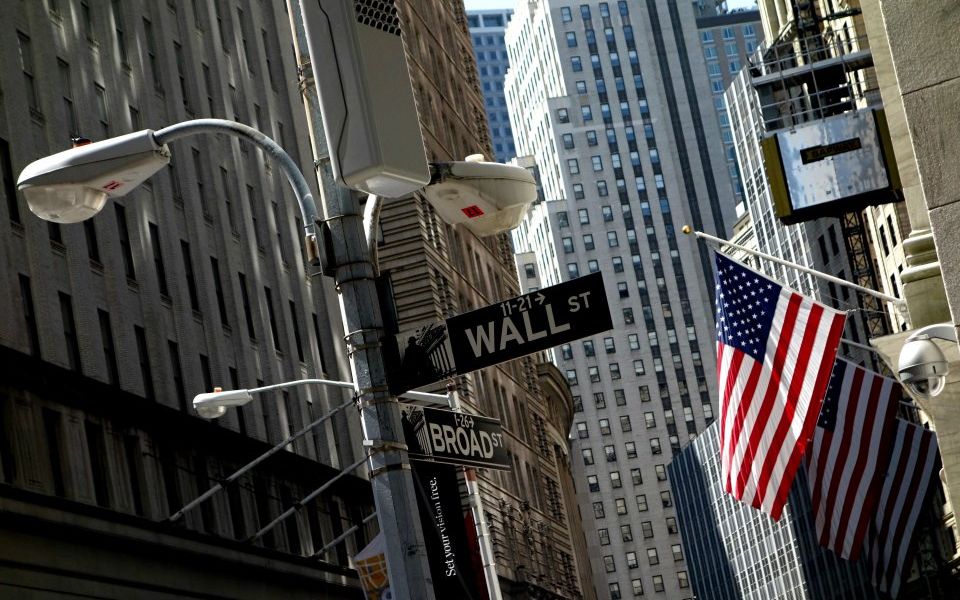Economy
US Shares Open Lower on Global Economic Concerns

By Investors Hub
The major U.S. index futures are pointing to a lower opening on Tuesday, with stocks likely to give back ground following the rally seen last week.
Concerns about the global economy are likely to weigh on the markets after the International Monetary Fund said the global expansion is weakening at a rate that is somewhat faster than expected.
The IMF lowered its forecasts for global economic growth to 3.5 percent in 2019 and 3.6 percent in 2020, 0.2 and 0.1 percentage points below last October?s projections.
An escalation of trade tensions and a worsening of financial conditions are key sources of risk to the outlook, the IMF said.
The IMF also expressed concerns about a bigger than expected slowdown in Chinese growth, the Brexit cliffhanger, and the ongoing U.S. government shutdown.
In remarks at the World Economic Forum in Davos, Switzerland, on Monday, IMF Managing Director Christine Lagarde noted risks to the global economy are increasingly intertwined.
?Think of how higher tariffs and rising uncertainty over future trade policy fed into lower asset prices and higher market volatility,? Lagarde said. ?This in turn contributed to tightening financial conditions, including for advanced economies, which is a major risk factor in a world of high debt burdens. ?
?Does that mean that a global recession is around the corner? The answer is ?no,?? she added. ?But the risk of a sharper decline in global growth has certainly increased.?
Extending the upward trend seen over the past several sessions, stocks moved sharply higher during the trading day on Friday. With the continued advance, the major averages reached their best closing levels in well over a month.
The major averages ended the day firmly in positive territory. The Dow soared 336.25 points or 1.4 percent to 24,706.35, the Nasdaq jumped 72.76 points or 1 percent to 7,157.23 and the S&P 500 surged up 34.75 points or 1.3 percent to 2,670.71.
Reflecting the four-day winning streak, the major averages moved substantially higher for the week. The Dow spiked by 3 percent, while the Nasdaq and the S&P 500 shot up by 2.7 percent and 2.9 percent, respectively.
The rally on Wall Street comes as traders continued to express optimism about trade talks between the U.S. and China.
Adding to the positive sentiment, a report from Bloomberg News said China has offered to go on a six-year buying spree to ramp up imports from the U.S.
An official familiar with the negotiations told Bloomberg that China would seek to reduce its trade surplus with the U.S. by increasing annual goods imports by a combined value of more than $1 trillion.
The Bloomberg report came on the heels of yesterday’s Wall Street Journal report indicating the U.S. is considering lifting tariffs on Chinese goods.
The Wall Street Journal report on Thursday said the U.S. is weighing easing tariffs in an effort to calm markets and give China an incentive to make deeper concessions.
People close to internal deliberations told the Journal that Treasury Secretary Steven Mnuchin proposed the idea of lifting some or all tariffs in a series of strategy meetings.
The people said the aim of easing the tariffs is to advance trade talks and win China’s support for longer-term reforms.
The positive news on trade overshadowed a report from the University of Michigan showing a substantial deterioration in U.S. consumer sentiment in the month of January.
The preliminary report said the consumer sentiment index plummeted to 90.7 in January from the final December reading of 98.3. Economists had expected the index to dip to 97.0.
With the much steeper than expected drop, the consumer sentiment index tumbled to its lowest level since hitting 87.2 in October of 2016.
“Consumer sentiment declined in early January to its lowest level since Trump was elected,” said Surveys of Consumers chief economist Richard Curtin. “The decline was primarily focused on prospects for the domestic economy, with the year-ahead outlook for the national economy judged the worst since mid 2014.”
He added, “The loss was due to a host of issues including the partial government shutdown, the impact of tariffs, instabilities in financial markets, the global slowdown, and the lack of clarity about monetary policies.”
Meanwhile, a separate report from the Federal Reserve showed industrial production increased by slightly more than expected in December, as jumps in manufacturing and mining output more than offset a sharp pullback in utilities output.
The Fed said industrial production rose by 0.3 percent in December after climbing by a downwardly revised 0.4 percent in November.
Economists had expected industrial production to edge up by 0.2 percent compared to the 0.6 percent advance originally reported for the previous month.
Oil service stocks moved sharply higher over the course of the trading session, driving the Philadelphia Oil Service Index up by 3.8 percent to its best intraday level in well over a month. The rally by oil service stocks came amid a significant increase by the price of crude oil.
Substantial strength was also visible among transportation stocks, as reflected by the 2.6 percent spike by the Dow Jones Transportation Average.
Trucking company J.B. Hunt Transport Services (JBHT) posted a standout gain after reporting better than expected fourth quarter results.
Computer hardware stocks also showed a significant move to the upside, resulting in a 2.6 percent jump by the NYSE Arca Computer Hardware Index.
Semiconductor, tobacco, banking, and networking stocks also moved notably higher, reflecting broad based buying interest.
Economy
NBA Demands Suspension of Controversial Tax Laws

By Modupe Gbadeyanka
The federal government has been asked by the Nigerian Bar Association (NBA) to suspend the implementation of the controversial tax laws.
In a reaction to the tax reform acts, the president of the group, Mr Afam Osigwe (SAN), the suspension of the laws would allow for a proper investigation into allegations of alterations in the gazetted and harmonised copies.
A member of the House of Representatives, Mr Abdussamad Dasuki, alleged that some parts of the laws passed by the parliament were different from the gazetted copy.
To address the issues raised, the NBA said it is “imperative that a comprehensive, open, and transparent investigation be conducted to clarify the circumstances surrounding the enactment of the laws and to restore public confidence in the legislative process.”
“Until these issues are fully examined and resolved, all plans for the implementation of the Tax Reform Acts should be immediately suspended,” the association declared.
It noted that the controversies “raise grave concerns about the integrity, transparency, and credibility of Nigeria’s legislative process.”
“These developments strike at the very heart of constitutional governance and call into question the procedural sanctity that must attend lawmaking in a democratic society,” it noted.
“Legal and policy uncertainty of this magnitude has far-reaching consequences. It unsettles the business environment, erodes investor confidence, and creates unpredictability for individuals, businesses, and institutions required to comply with the law. Such uncertainty is inimical to economic stability and should have no place in a system governed by the rule of law.
“Nigeria’s constitutional democracy demands that laws, especially those with profound economic and social implications, emerge from processes that are transparent, accountable, and beyond reproach. Anything short of this undermines public trust and weakens the foundation upon which lawful governance rests.
“We therefore call on all relevant authorities to act swiftly and responsibly in addressing this controversy, in the overriding interest of constitutional order, economic stability, and the preservation of the rule of law,” the organisation stated.
Economy
MRS Oil, Two Others Raise NASD Bourse Higher by 0.52%

By Adedapo Adesanya
Demand for hot stocks, including MRS Oil Plc, buoyed the NASD Over-the-Counter (OTC) Securities Exchange by 0.52 per cent on Tuesday, December 23.
The energy company was one of the three price gainers for the session as it chalked up N19.69 to sell at N216.59 per share versus the previous day’s value of N196.90 per share.
Further, FrieslandCampina Wamco Nigeria Plc gained N2.95 to close at N56.75 per unit versus N53.80 per unit and Golden Capital Plc appreciated by 84 Kobo to N9.29 per share from Monday’s N8.45 per share.
Consequently, the market capitalisation went up by N10.95 billion to N2.125 trillion from N2.125 trillion and the NASD Unlisted Security Index (NSI) rose by 18.31 points to 3,570.37 points from 3,552.06 points.
Yesterday, the NASD bourse recorded a price loser, the Central Securities Clearing System Plc (CSCS), which gave up 17 Kobo to close at N33.70 per unit against the previous trading value of N33.87 per unit.
The volume of securities traded at the session went down by 97.6 per cent to 297,902 units from the previous day’s 12.6 million units, the value of securities decreased by 98.5 per cent to N10.5 million from N713.6 million, and the number of deals remained flat at 32 deals.
By value, Infrastructure Credit Guarantee Company (InfraCredit) Plc ended as the most actively traded stock on a year-to-date basis with 5.8 billion units exchanged for N16.4 billion. This was followed by Okitipupa Plc, which traded 178.9 million units valued at N9.5 billion, and MRS Oil Plc with 36.1 million units worth N4.9 billion.
In terms of volume, also on a year-to-date basis, InfraCredit Plc led the chart with a turnover of 5.8 billion units traded for N16.4 billion. Industrial and General Insurance (IGI) Plc ranked second with 1.2 billion units sold for N420.7 million, while Impresit Bakolori Plc followed with the sale of 536.9 million units valued at N524.9 million.
Economy
NGX All-Share Index Soars to 153,354.13 points

By Dipo Olowookere
It was another bullish trading session for the Nigerian Exchange (NGX) Limited as it closed higher by 0.59 per cent on Tuesday.
The market further rallied due to continued interest in large and mid-cap stocks on the exchange by investors rebalancing their portfolios for the year-end.
Yesterday, Aluminium Extrusion sustained its upward trajectory after it further appreciated by 9.96 per cent to N14.90, as Austin Laz gained 9.81 per cent to close at N2.91, Custodian Investment improved by 9.69 per cent to N38.50, and First Holdco soared by 9.35 per cent to N50.30.
Conversely, Royal Exchange declined by 7.22 per cent to N1.80, Champion Breweries shrank by 6.57 per cent to N15.65, NASCON lost 5.36 per cent to trade at N105.05, Sovereign Trust Insurance depreciated by 5.28 per cent to N3.77, and Japaul went down by 4.51 per cent to N2.33.
At the close of business, 29 shares ended on the gainers’ table and 27 shares finished on the losers’ log, representing a positive market breadth index and bullish investor sentiment.
This raised the All-Share Index (ASI) by 895.06 points to 153,354.13 points from 152,459.07 points and lifted the market capitalisation by N579 billion to N97.772 trillion from the previous day’s N97.193 trillion.
VFD Group finished the day as the busiest stock after it recorded a turnover of 192.0 million units worth N2.1 billion, GTCO exchanged 63.5 million units valued at N5.6 billion, Access Holdings traded 49.8 million units for N1.0 billion, First Holdco sold 45.8 million units valued at N2.3 billion, and Secure Electronic Technology transacted 38.3 million units worth N28.4 million.
In all, market participants bought and sold 677.4 million units valued at N20.8 billion in 27,589 deals compared with the 451.5 million units worth N13.0 billion traded in 33,327 deals on Monday, showing an improvement in the trading volume and value by 50.03 per cent and 60.00 per cent apiece, and a shortfall in the number of deals by 17.22 per cent.
-

 Feature/OPED6 years ago
Feature/OPED6 years agoDavos was Different this year
-
Travel/Tourism9 years ago
Lagos Seals Western Lodge Hotel In Ikorodu
-

 Showbiz3 years ago
Showbiz3 years agoEstranged Lover Releases Videos of Empress Njamah Bathing
-

 Banking8 years ago
Banking8 years agoSort Codes of GTBank Branches in Nigeria
-

 Economy3 years ago
Economy3 years agoSubsidy Removal: CNG at N130 Per Litre Cheaper Than Petrol—IPMAN
-

 Banking3 years ago
Banking3 years agoFirst Bank Announces Planned Downtime
-

 Banking3 years ago
Banking3 years agoSort Codes of UBA Branches in Nigeria
-

 Sports3 years ago
Sports3 years agoHighest Paid Nigerian Footballer – How Much Do Nigerian Footballers Earn













